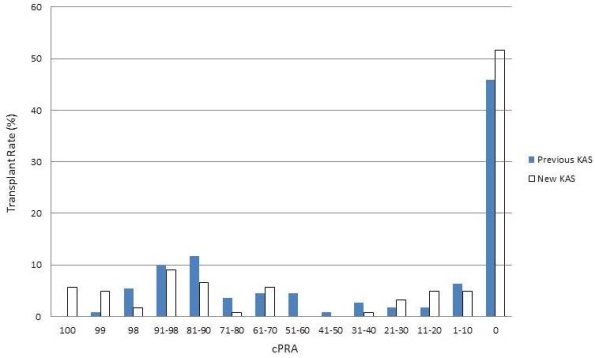Impact of New Kidney Allocation System on Transplant Rates for Highly Sensitized Patients-Center Specific Study.
Comprehensive Transplant Center, Cedars-Sinai Medical Center, Los Angeles, CA.
Meeting: 2016 American Transplant Congress
Abstract number: C197
Keywords: Allocation, Kidney transplantation, Panel reactive antibodies
Session Information
Session Name: Poster Session C: Kidney Transplantation: AKI/Preservation/DCD
Session Type: Poster Session
Date: Monday, June 13, 2016
Session Time: 6:00pm-7:00pm
 Presentation Time: 6:00pm-7:00pm
Presentation Time: 6:00pm-7:00pm
Location: Halls C&D
Aim: Our renal transplant program promotes transplant of highly sensitized patients (pts) through desensitization and listing only strong antibodies as unacceptable antigens (UAs). UNOS implemented a new kidney allocation system (New KAS) starting from December 4, 2014 with the goal of increasing transplant of highly sensitized pts. In this study, we aimed to determine the effects of the New KAS on our pts transplanted from the deceased donor.
Methods: We evaluated isolated kidney transplants from the deceased donor waitlist during the first year of the new KAS (12/4/2014-12/03/2015) and compared to the previous year of the pre KAS (12/4/2011-12/3/2014). Pediatric pts were excluded in this analysis. Antibodies with MFI 10,000 in neat or 1:8 dilution sera, or C1q positive antibodies or CDC positive antibodies were listed as UAs in UNet.
Results: The number of deceased donor isolated kidney transplants slightly increased in the New KAS as compared to the Previous KAS (122 vs 111). No difference was observed in the rate of transplant of pts with 0% cPRA. Transplant of highly sensitized pts with cPRA 99% and 100% rose significantly (New KAS vs Previous KAS, 10.6% vs 0.9%, p=0.001). In the New KAS, however, the percentage of pts with cPRA 98% receiving allografts didn't increase (5.4% in Pre KAS to 1.6% in New KAS, p=0.12), suggesting the national and regional sharing policy, instead of the sliding point scale of cPRA, mainly contributes to the increased transplant rate for highly sensitized pts. No pts with cPRA 41-60 % were transplanted under the new KAS system while 5.4% of pts in this category were transplanted pre KAS (p=0.01).
Conclusion: The data show that the New KAS increases transplant of pts with cPRA 99% and 100% through broader sharing. Combined transplant rates of highly sensitized pts (>98% cPRA) were 16.2% and 12.3% for Pre and New KAS, respectively. In contrast, the national average increased from 2.3% (pre KAS) to 14.8% (New KAS). These results suggest that our strategy to transplant the highly sensitized pts has been consistently working in both KAS eras.
 .
.
CITATION INFORMATION: Zhang X, Naim M, Vo A, Jordan S, Reinsmoen N. Impact of New Kidney Allocation System on Transplant Rates for Highly Sensitized Patients-Center Specific Study. Am J Transplant. 2016;16 (suppl 3).
To cite this abstract in AMA style:
Zhang X, Naim M, Vo A, Jordan S, Reinsmoen N. Impact of New Kidney Allocation System on Transplant Rates for Highly Sensitized Patients-Center Specific Study. [abstract]. Am J Transplant. 2016; 16 (suppl 3). https://atcmeetingabstracts.com/abstract/impact-of-new-kidney-allocation-system-on-transplant-rates-for-highly-sensitized-patients-center-specific-study/. Accessed January 1, 2026.« Back to 2016 American Transplant Congress
